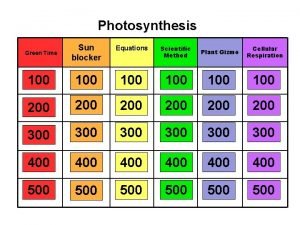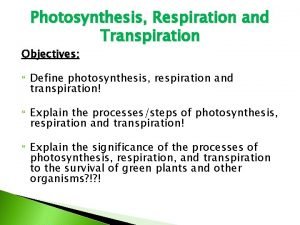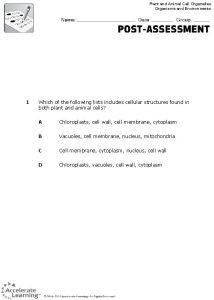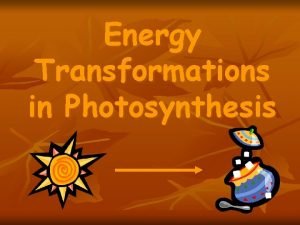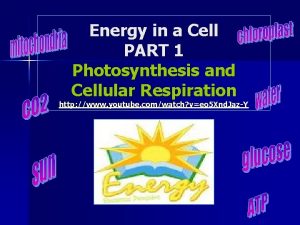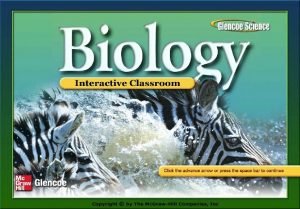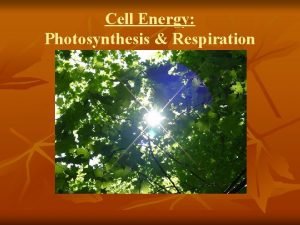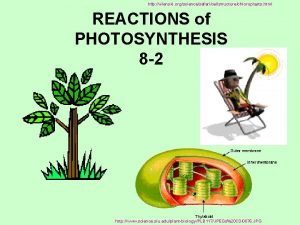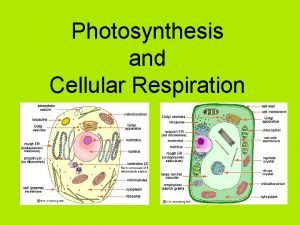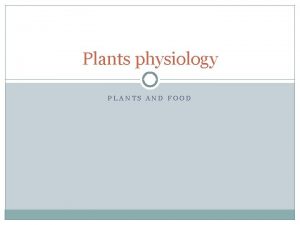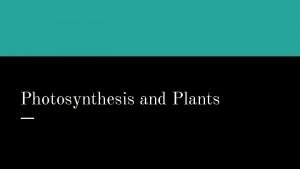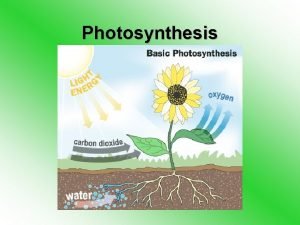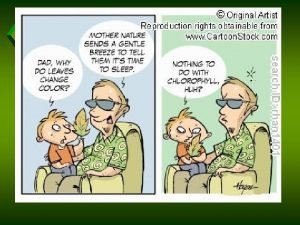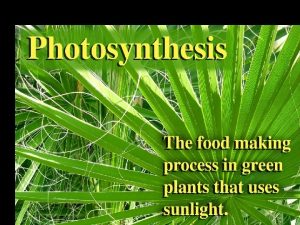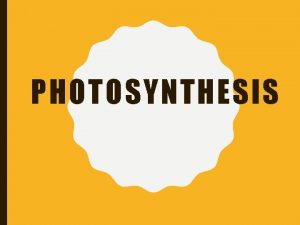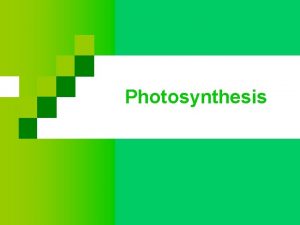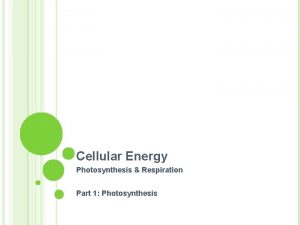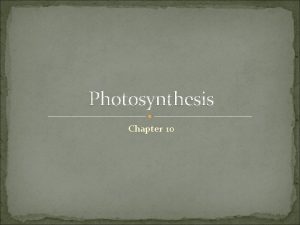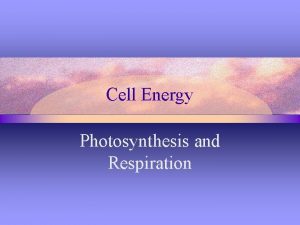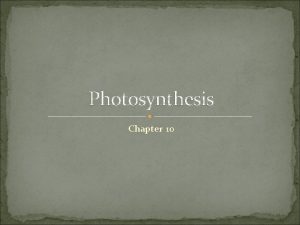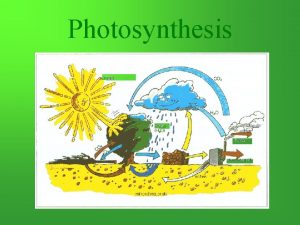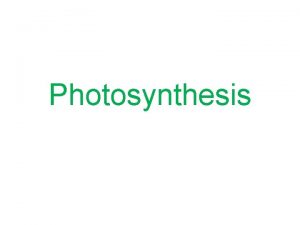Photosynthesis Energy Life 1 Photosynthesis Plants use the


![The Photosynthesis Equation [Waste product] 3 The Photosynthesis Equation [Waste product] 3](https://slidetodoc.com/presentation_image_h/deaaffa741baacd093c14abbfbfbbd4e/image-3.jpg)








![Samuel Ruben & Martin Kamen Used Isotopes to determine that the Oxygen liberated[relea sed] Samuel Ruben & Martin Kamen Used Isotopes to determine that the Oxygen liberated[relea sed]](https://slidetodoc.com/presentation_image_h/deaaffa741baacd093c14abbfbfbbd4e/image-12.jpg)






































- Slides: 50

Photosynthesis Energy & Life 1

Photosynthesis • Plants use the Energy of sunlight to convert Water (H 20) and Carbon Dioxide (CO 2) into Oxygen (O 2) and High Energy Carbohydrates (sugars, e. g. Glucose) & Starches 2
![The Photosynthesis Equation Waste product 3 The Photosynthesis Equation [Waste product] 3](https://slidetodoc.com/presentation_image_h/deaaffa741baacd093c14abbfbfbbd4e/image-3.jpg)
The Photosynthesis Equation [Waste product] 3

Glucose • Glucose is a monosaccharide • C 6 H 12 O 6 • One Molecule of glucose Stores 90 Times More Chemical Energy Than One Molecule of ATP 4

History of Photosynthesis 5

Early Questions on Plants Several Centuries Ago, The Question Was: Does the increase in plant mass come from the air? The soil? The water? 7

Van Helmont’s Experiment 1643 • • • Planted a seedling into A pre-measured amount of soil and watered for 5 years. Weighed Plant & Soil. Plant- gained 75 kg, Soil - same weight. Concluded increase in Mass Came From Water 8

Priestley’s Experiment • • • Burned candle in Bell Jar until it went out. If placed sprig of Mint in Bell Jar for a few days, candle could be relit and burn. Concluded plants released substance (O 2) necessary for burning. 1771 9

Ingenhousz’s Experiment 1779 10 Repeated Priestly experiment with & without sunlight

Results of Ingenhousz’s Experiment • Showed that Priestley’s results only occurred in the presence of Sunlight. • Light was necessary for plants to produce the “burning gas” or oxygen 11

Julius Robert Mayer 1845 Proposed that plants can convert Light Energy into Chemical Energy 12
![Samuel Ruben Martin Kamen Used Isotopes to determine that the Oxygen liberatedrelea sed Samuel Ruben & Martin Kamen Used Isotopes to determine that the Oxygen liberated[relea sed]](https://slidetodoc.com/presentation_image_h/deaaffa741baacd093c14abbfbfbbd4e/image-12.jpg)
Samuel Ruben & Martin Kamen Used Isotopes to determine that the Oxygen liberated[relea sed] in Photosynthesis comes from water 1941 RUBIN 13 KAMEN

Melvin Calvin 1948 • First to trace the path that carbon (CO 2) takes in forming Glucose • Does NOT require sunlight • Called the Calvin Cycle or Light Independent Reaction • Also known as the Dark Reaction 14

Autotrophs Organisms that contain chlorophyll and are able to use light energy from the sun to produce their own food. Euglena Plant 16

Heterotrophs • Heterotrophs are organisms that can NOT make their own food • Heterotrophs can NOT directly use the sun’s energy 17

Importance of ATP Principal Compound Used To Store Energy In Living Organisms 18

Cells Using Biochemical Energy Cells Use ATP For: • Active transport • Movement • Photosynthesis • Protein Synthesis • Cellular respiration • All other cellular reactions EVERYTHING! 19

ATP – Cellular Energy • Adenosine Triphosphate • Contains two, high-energy phosphate bonds • Also contains the nitrogen base adenine & a ribose sugar 20

Sugar in ADP & ATP • Called ribose • Pentose sugar • Also found in RNA 21

Releasing Energy From ATP • ATP provides all of the energy for cell activities • The high energy phosphate bonds are BROKEN to release energy • ATP is constantly being used and remade by cells • The process of releasing ATP’s energy & reforming the molecule is called phosphorylation 22

Phosphorylation Enzyme in thylakoid membrane called ATP Synthase As H+ ions passed through thylakoid membrane, enzyme binds them to ADP Forms ATP for cellular 23

Releasing Energy From ATP • Adding A Phosphate Group To ADP stores Energy in ATP • Removing A Phosphate Group From ATP Releases Energy & forms ADP. Loose Gain 24

More on ATP • Cells Have Enough ATP To Last For A Few Seconds • ATP must constantly be made • ATP Transfers Energy Very Well • ATP Is NOT Good At Energy Storage 25

Plant Pigments & Cell Structure 26

• Energy From The Sun Enters Earth’s Biosphere As Photons, a light energy unit. Longest wavelength Light and Pigments • Different wavelengths are seen as Different Colors Shortest wavelength • Visible or ‘White’ Light contains a mixture Of different wavelengths 27

Pigments • In addition to water, carbon dioxide, and light energy, photosynthesis requires Pigments • Chlorophyll is the primary lightabsorbing pigment in autotrophs • Chlorophyll is found inside chloroplasts 28

Chlorophyll There are 2 main types of chlorophyll molecules: Chlorophyll a Chlorophyll b A third type, chlorophyll c, is found in dinoflagellates 29

Light wavelength absorbed by pigments Chlorophyll a absorbs Blue = best Red = 2 nd best Chlorophyll reflects green 30

Chlorophyll • Absorbs blue wavelength best and red wavelength 2 nd best. • Does NOT absorb green wavelength, but reflects green wavelength. • This is why plants look green. 31

Carotenoids • Plant pigment • Absorbs light energy best in the yellow, orange and red wavelengths. • Chlorophyll masks these pigments 32

Color Note • pigments that absorb all wavelengths of light are black. • pigments that reflect all wavelengths of light are white. 33

Chlorophyll a • Found in all plants, algae, & cyanobacteria • Makes photosynthesis possible • Participates directly in the Light Reactions • Can accept energy from chlorophyll b 34

Chlorophyll b • Chlorophyll b is an accessory pigment • Chlorophyll b acts indirectly in photosynthesis by transferring the light it absorbs to chlorophyll a • Like chlorophyll a, it absorbs red & blue light and REFLECTS GREEN 35

Leaf Structures • Cuticle- Waxy outer layer • Epidermal Cells – Waxy and rigid outer cell layer. • Stomata - Openings in the epidermis that allow gas and water exchange. • Mesophyll layer- spongy layer of cells within leaf where photosynthesis takes place. 36

Leaf Structure 37

Structure of the Chloroplast • Double membrane organelle • Thylakoids – flattened sac that contains photosynthesis pigments. Where light dependent reactions occur. • Granun (grana-plural) Stack of connected Thylakoid sacks. • Stroma- Gel-like material around grana. 38

Inside A Chloroplast 39

Light & Pigments • Pigments absorb different wavelengths of light which “excite” electrons in the plant’s pigments. • Excited electrons carry the absorbed energy • Electrons are transported by an electron carrier called NADP+ 40

Light Dependent Reactions • Occurs across the thylakoid membranes • Uses light energy • Produce Oxygen from water • Convert ADP to ATP • Also convert NADP+ into the energy carrier NADPH 41

Energy Carrier • NADP+ =Nicotinamide adenine dinucleotide phosphate • Accepts 2 high energy electrons and a H+ from the Light Reaction which convert NADP+ into NADPH. • High energy electrons used to build molecules cell needs like glucose. 42

NADPH 43

Light Dependent Reaction 44

Light Reaction Summary Reactants: • H 2 O • Light Energy Products: • Oxygen Energy to drive Dark Reaction • • ATP NADPH 45

Function of the Stroma • Light Independent reactions occur here • ATP used to make carbohydrates like glucose • Location of the Calvin Cycle 46

Light Independent Reaction • Also known as the Calvin Cycle OR Dark Reaction. • Does not require light. • Occurs in the stroma • Uses ATP and NADPH from the light-dependent reactions to produce high-energy sugars. 47

Light Independent Reaction • Uses: ATP & NADPH from light reactions used as energy source • 6 Atmospheric C 02 are used to make sugars like glucose and fructose • Six-carbon Sugars made during the Calvin Cycle 48

The Calvin Cycle 49

Light Independent Reaction Summary Reactants: • CO 2 • Energy from ATP & NADPH Products: • ADP • NADP+ • Sugars 50

Factors Affecting the Rate of Photosynthesis • Amount of available water • Temperature • Amount of available light energy 51

Photosynthesis Overview 52
 Photosynthesis transforms light energy into chemical energy
Photosynthesis transforms light energy into chemical energy The food that plants produce during photosynthesis is
The food that plants produce during photosynthesis is Where does photosynthesis happen
Where does photosynthesis happen Photosynthesis and respiration of plants
Photosynthesis and respiration of plants Green plants make their own food by photosynthesis
Green plants make their own food by photosynthesis Reproduce by spores
Reproduce by spores Nonvascular plants reproduction
Nonvascular plants reproduction Characteristics of non-flowering plants
Characteristics of non-flowering plants C3 plants vs c4 plants
C3 plants vs c4 plants Energy energy transfer and general energy analysis
Energy energy transfer and general energy analysis Energy energy transfer and general energy analysis
Energy energy transfer and general energy analysis Animal cells
Animal cells Best source of nitrogen
Best source of nitrogen Energy transformations in photosynthesis
Energy transformations in photosynthesis Photosynthesis energy transformation
Photosynthesis energy transformation Cellular energy section 2 photosynthesis answer key
Cellular energy section 2 photosynthesis answer key Chapter 6 cell energy photosynthesis and respiration
Chapter 6 cell energy photosynthesis and respiration Plants gather energy with light-absorbing pigments called *
Plants gather energy with light-absorbing pigments called * Hát kết hợp bộ gõ cơ thể
Hát kết hợp bộ gõ cơ thể Bổ thể
Bổ thể Tỉ lệ cơ thể trẻ em
Tỉ lệ cơ thể trẻ em Voi kéo gỗ như thế nào
Voi kéo gỗ như thế nào Chụp tư thế worms-breton
Chụp tư thế worms-breton Alleluia hat len nguoi oi
Alleluia hat len nguoi oi Môn thể thao bắt đầu bằng từ đua
Môn thể thao bắt đầu bằng từ đua Thế nào là hệ số cao nhất
Thế nào là hệ số cao nhất Các châu lục và đại dương trên thế giới
Các châu lục và đại dương trên thế giới Công thức tính độ biến thiên đông lượng
Công thức tính độ biến thiên đông lượng Trời xanh đây là của chúng ta thể thơ
Trời xanh đây là của chúng ta thể thơ Mật thư anh em như thể tay chân
Mật thư anh em như thể tay chân Làm thế nào để 102-1=99
Làm thế nào để 102-1=99 Phản ứng thế ankan
Phản ứng thế ankan Các châu lục và đại dương trên thế giới
Các châu lục và đại dương trên thế giới Thể thơ truyền thống
Thể thơ truyền thống Quá trình desamine hóa có thể tạo ra
Quá trình desamine hóa có thể tạo ra Một số thể thơ truyền thống
Một số thể thơ truyền thống Cái miệng xinh xinh thế chỉ nói điều hay thôi
Cái miệng xinh xinh thế chỉ nói điều hay thôi Vẽ hình chiếu vuông góc của vật thể sau
Vẽ hình chiếu vuông góc của vật thể sau Thế nào là sự mỏi cơ
Thế nào là sự mỏi cơ đặc điểm cơ thể của người tối cổ
đặc điểm cơ thể của người tối cổ Giọng cùng tên là
Giọng cùng tên là Vẽ hình chiếu đứng bằng cạnh của vật thể
Vẽ hình chiếu đứng bằng cạnh của vật thể Tia chieu sa te
Tia chieu sa te Thẻ vin
Thẻ vin đại từ thay thế
đại từ thay thế điện thế nghỉ
điện thế nghỉ Tư thế ngồi viết
Tư thế ngồi viết Diễn thế sinh thái là
Diễn thế sinh thái là Các loại đột biến cấu trúc nhiễm sắc thể
Các loại đột biến cấu trúc nhiễm sắc thể Các số nguyên tố
Các số nguyên tố

